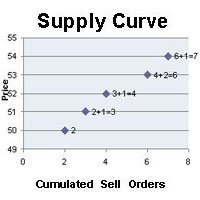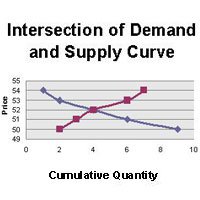

Heatmap Streamer
In the continuous market a trade occurs whenever a buy order and a sell order match
each other at a price during the hours when the market is open. In a Call Auction
market, orders are gathered for execution at predetermined times when the market
is called. At the call, all buy orders are aggregated into a downward sloping demand
function and all sell orders are aggregated in an upward sloping supply function.
The market opening price and quantity traded are derived based on aggregated supply and demand for the underlying The orders that trade and the price and quantity at which they trade, are set by multilateral matching, rather than by the sequence of bilateral matching used to determine trades in a continuous market.
The concept of order batching which is core to the call auction mechanism. can be understood with the help of an example. We look at simple order book which shows buy and sell quantities at various price points.
| 1 |
54 |
50 |
2 |
| 1 |
53 |
51 |
1 |
| 2 |
52 |
52 |
1 |
| 2 |
51 |
53 |
2 |
| 3 |
50 |
54 |
1 |
|
The graphs below display how buy and sell orders are batched together to bring about an equilibrium quantity and price. The vertical axis shows the price and the horizontal axis shows the quantity.
Figure 1: Cumulation of Buy Orders
All the buy orders are cumulated to form a downward sloping demand function. The cumulation happens from the highest to the lowest price. The highest buy order is at price 54 at which there is order of quantity 1. At price 53, an additional order of quantity 1 has been placed. This makes the cumulative quantity 2 orders at price 53. Similarly at price points 52, 51 and 50 the cumulative quantity is 4,6 and 9 orders respectively. Thus the cumulative buy quantity increases as the price decreases.

Figure 2: Cumulative of Sell Orders
Similar to the cumulation for the buy orders, all the sell orders are cumulated to form an upward sloping supply function. The sell orders are cumulated from the lowest to the highest price. The lowest sell order of quantity 1 is at a price of 50. At price 51 there are 2 orders making the cumulative quantity to 3 orders. Similarly, at price points 52, 53, 54 the cumulative sell quantity will be 4, 6 and 7 orders respectively. Thus the cumulative sell quantity increases as the sell price increases.

In figure 3: Intersection of cumulative buy orders and cumulative
The intersection of the demand and supply function occurs at price 52 where the quantity executable is maximum at 4 orders. Buy orders at and above 52 (53,54) and sell orders at and below 52 (51,50) are eligible to be executed at the single price determined (i.e the call auction price of 52).
Thus the intersection of the downward sloping demand function consisting of buy orders and upward sloping supply function consisting of sell orders determines the equilibrium quantity traded and the price. The call auction mechanism allows the most aggressively priced buy and sell orders to match each other and some orders (buy orders priced at 53 and 54 and sell orders priced at 51 and 50) receive a price improvement during execution. All other orders which are priced less aggressively (i.e. buy orders priced at lower than the call auction price and the sell orders priced at higher than the call auction price) will not be executed. These orders may be cancelled, moved on the continuous session or kept pending for the next call session depending on the Exchange specifications.
Call Auctions across the world have been applied to various sessions during the trading day –
- At the Open
- At the Close
- Intraday
- Post Halt
- IPO Listing